Subjects:
- Air cooling vs. liquid cooling
- Types of coolant
- Coolant components
- Determining antifreeze content
- Coolant change interval
- Change coolant
- Latest generation coolant
Air cooling vs. liquid cooling:
In liquid-cooled engines, there are cooling channels in the engine block and cylinder head through which coolant flows. The coolant does not actually cool, but absorbs the heat from the parts and transfers this heat to the radiator. Here the coolant is cooled by the wind. Then the cooled coolant flows again past warm engine parts to absorb heat.
Advantages of liquid cooling compared to wind cooling:
- Even cooling. The flow of the coolant can be precisely controlled. The heat can be better controlled when dissipating, so that there are smaller temperature differences. Coolant absorbs heat very quickly, can store a lot of heat and is nice and thin, so that it can be pumped quickly through the cooling system.
- Less engine noise. The fluid around the cylinders has a sound damping effect.
- If the engine is stopped after a long ride, it will stay at temperature longer (beneficial during driving breaks, then the engine is less cold after a restart). The coolant then causes the engine to cool down more slowly. During slow cooling, fewer material stresses occur than when some engine parts cool faster than others.
Types of coolant:
Coolant can be found in a number of types and colours:
- Green or blue (G11). Contains silicates (salts) and can be used in older engines. Most commonly used, eg BMW and most MINIs.
- Red / Yellow (G12). This coolant is suitable for aluminum engines and the silicates have been replaced by Organic Acid Technology (OAT). We find yellow coolant at Renault, among others;
- Purple / colorless (G12+). This universal coolant contains improved additives compared to red or yellow coolant;
- Red / Pink (G12++, G13). Contains silicate additives and gives extra aluminum protection in modern engines, is suitable for long-life applications and is mainly used by Volkswagen / Audi etc.
Before adding coolant, it must first be determined which type (color) belongs in it. Adding and/or mixing the wrong type of coolant can be harmful to the engine components.
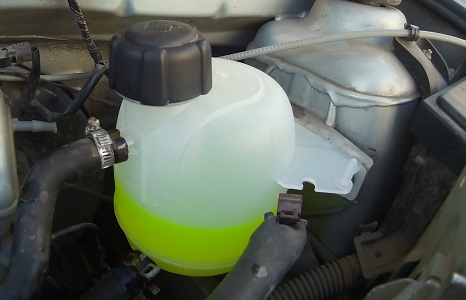
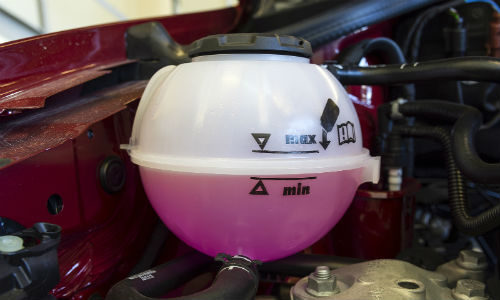
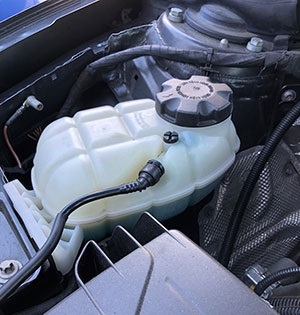
Coolant components:
Coolant consists of a mixture of demineralized water, antifreeze (glycol) and additives (additives). These additions provide protection to engine components and cooling system components and are referred to as “dopes”.
- Water: Lime and chlorine have been removed from the demineralized water, so that no blockages occur and engine parts are not affected.
- Antifreeze: Antifreeze (glycol) is added to coolant to lower the freezing point. Without antifreeze, the coolant would freeze at 0°C and engine parts could damage (crack) due to the expansion of frozen water. Adding antifreeze lowers the freezing point between -25°C and -40°C. Mono Ethylene Glycol (MEG) or Mono Propylene Glycol (MPG) can be used as antifreeze, of which the MEG has a greater heat absorbing capacity and is therefore the most used, and the MPG is the least harmful to the environment. The mixing ratio between water and antifreeze determines the freezing point.
– a mix of 30:70 (30% antifreeze and 70% water) is often sufficient in temperate climates;
– in climates where the temperature often drops well below freezing, the mixtures are adjusted at 60:40 or 70:30. - Additives: The additives in coolant are called additives. The additions ensure even better properties of the coolant:
– anti-foam dope: when coolant foams, less heat is absorbed and this hinders circulation. Foaming can also cause cavitation. Catitation occurs when air bubbles suddenly implode due to a change in pressure. The resulting pressure waves can even break pieces of metal parts;
– anti sludgedope: the clumping of components can lead to blockages;
– Anti-corrosion dopes: Because the components of the engine and coolant are made of different metals, electrolytic corrosion can occur.
The anti-corrosion dope prevents this corrosion by counteracting the conductivity;
– Lubrication: with the addition of a lubricant, the coolant pump oil seal prevents wear. Without lubricant, there is more friction between the shaft and the seal and can cause squeaking noises and the seal can wear faster and start to leak.
Determining antifreeze content:
During a (major) maintenance of a car, the antifreeze content of the coolant is checked. Over time, the amount of antifreeze may have decreased, for example after adding water. The antifreeze content can be checked in two ways:
- With a refractometer one can measure the refraction of light by liquids. We call this an optical meter. The higher the antifreeze content, the slower light passes through and the stronger the bending effect on light. By applying a few drops of coolant to the glass, one can view the light at the breaking point through the sight glass. Then you look at the light through the peephole. The dividing line between white and blue (see the picture below) indicates the temperature up to which the coolant offers protection. In the example it is -28 °C. When tap water is measured without additives, the separation will drop to 0 °C;
- The antifreeze weigher measures the specific gravity of the coolant. Antifreeze has a higher specific gravity than water. The mixing ratio affects the weight. The higher the weight, the more antifreeze is present.
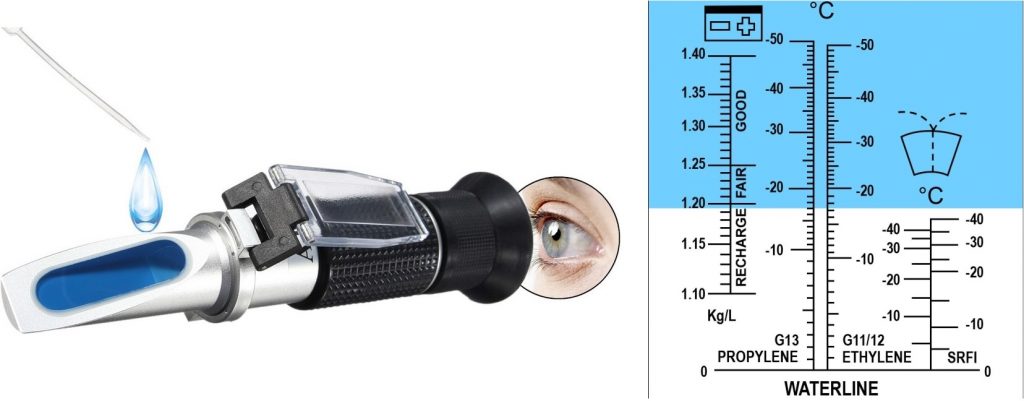
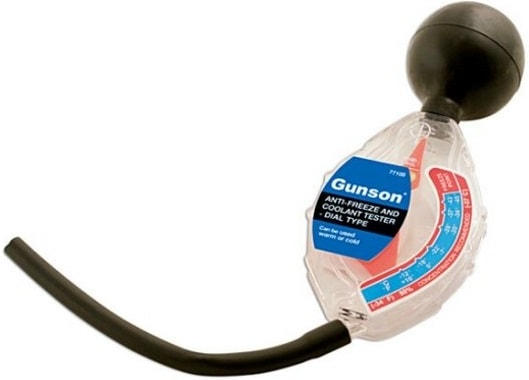
If it is found that the antifreeze level is too low, the coolant should be changed. Adding pure antifreeze to the existing coolant is not recommended. The next section shows why it is better to replace the coolant.
Coolant change interval:
Coolant is often not changed periodically, as is the case with engine oil. Manufacturers usually do not specify a replacement term. However, it is advisable to change the coolant every few years. Over time, the dopes wear out and no longer offer protection against foaming, sludge, corrosion and the coolant no longer has a lubricating effect. When corrosion occurs in the engine block, metals dissolve a little in water. The differences in 'tendency' to resolve gives a kind of battery operation. An electrical voltage is created between the different metals and a circuit can arise in which one of the two metals corrodes. If the coolant also contains salts or acids, for example tap water has been used, the conductivity is enhanced.
In addition to the increasing risk of corrosion, pollution is also increasing. Through sweaty gaskets, wear of the water pump and wafer-thin metal particles due to erosion of the liquid flow, the coolant becomes contaminated and causes more wear.
It is advisable to change the coolant every two years, or at the latest four years and a maximum of 50.000 km. After repairs have been made to, for example, the radiator, coolant pump or thermostat, it is better not to reuse the drained coolant. Filling with new coolant is preferred.
The images below show coolant where the dopes have been worked out and where a dilution with tap water has presumably taken place. The coolant turns brown, as do all parts and channels in the cooling system. This “rust water” can be flushed away with flushing, after which the system can be topped up with new coolant. If this is not done in time, defects can occur such as: leakage of the water pump, leaking seals and gaskets, clogged (heater) radiator, defective thermostat and deposits on the walls of the cooling system.
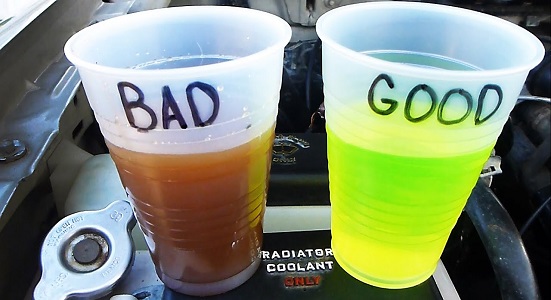
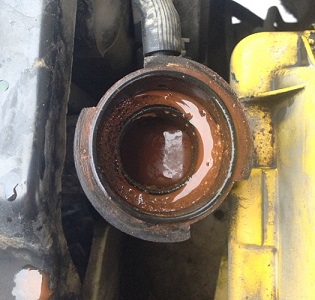
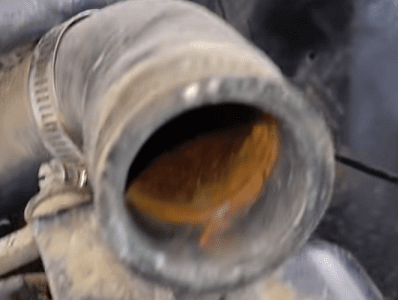
Change coolant:
There is often a drain plug on the underside of the radiator. If not present, the lower radiator hose can be pulled off to drain most of the cooling system. Some engines also have drain plugs on the engine block itself. Refer to the instruction manual in advance to find out the locations of the drain plugs.
After draining, the system can be filled. While in one car it is very easy to bleed, in the other car one or more bleed screws have to be partially opened to allow the remaining air to escape from the system via the highest point. There are engines where bleeding is so difficult that the car with the engine running has to be tilted backwards to allow the air bubbles present to escape via the highest point (the radiator cap or the expansion tank).
The best way to fill the cooling system is to vacuum it first. The entire cooling system can be vacuumed via a cap with taps and compressed air. By then opening the valve of the coolant reservoir, the new coolant is sucked into the system. In this case, no venting is required.
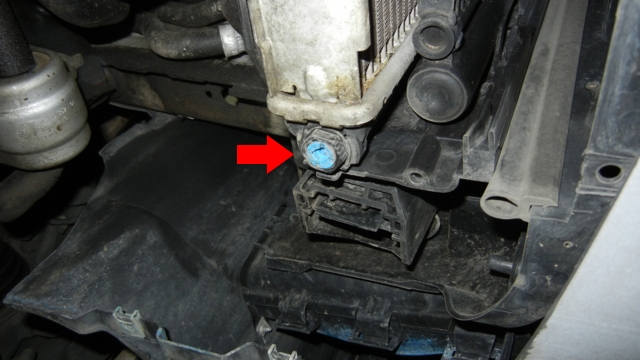
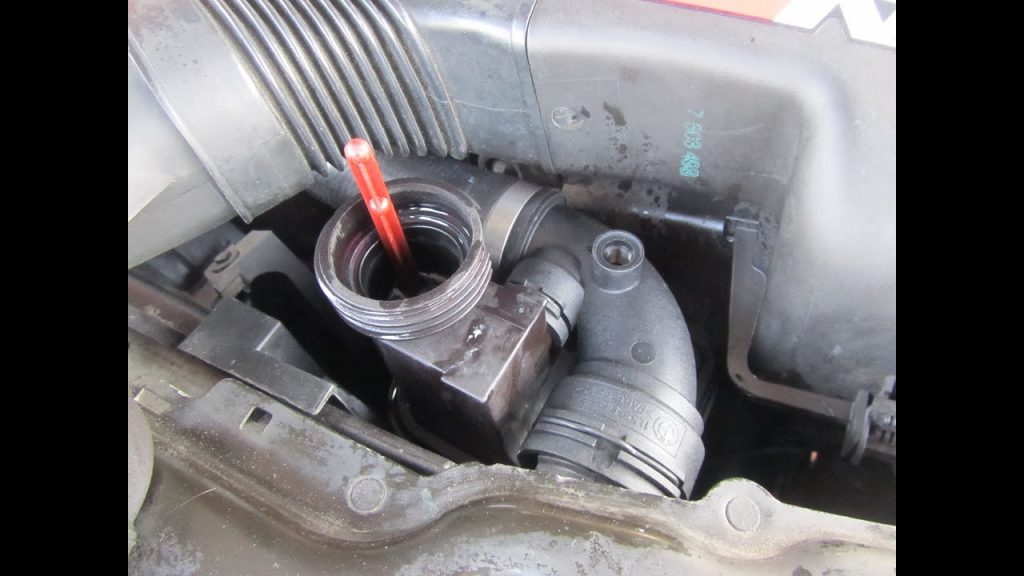
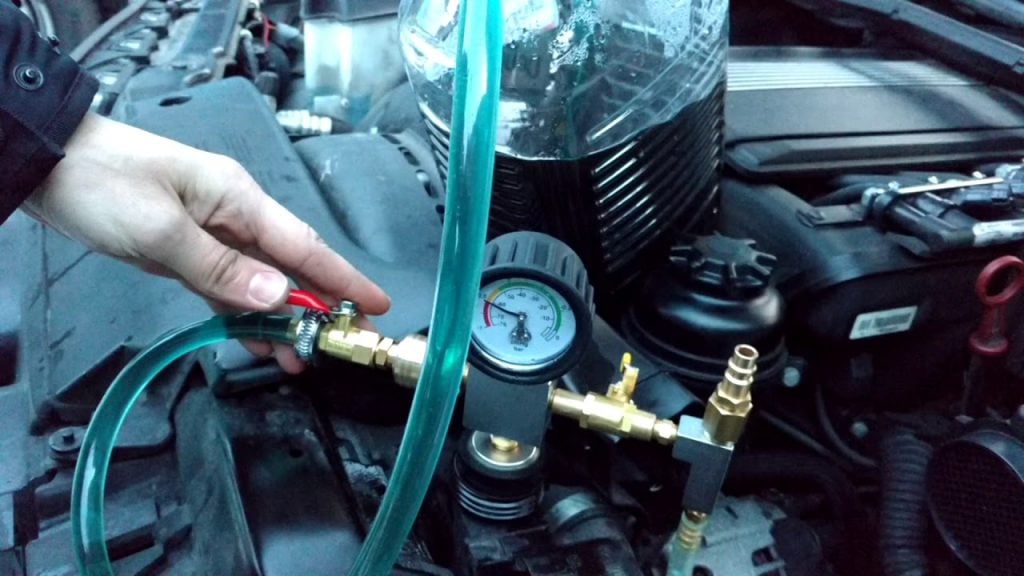
When the system has been filled and vented, it is possible to check in a fairly simple manner whether the circulation is in order. A clear return flow must be visible in the expansion tank. The stove must also be sufficiently warm. Is the engine at operating temperature, but the heater does not or hardly heat up? Or does the temperature rise briefly with gas, but then the air gets colder again? Then you know for sure that there are still air bubbles in the system.
Latest generation coolant:
The conventional anti-corrosion dopes are not able to sufficiently protect the combinations of the different materials. Short-term erosion takes place at the water pump and the cooling channels become clogged because the coolant turns into a kind of gel. In addition, plastics can harden, causing them to break. To prevent this, the latest generation of coolants is equipped with dopes made of organic carboxylic acids, which do not form a protective layer over metals, and therefore do not attack the metal.
